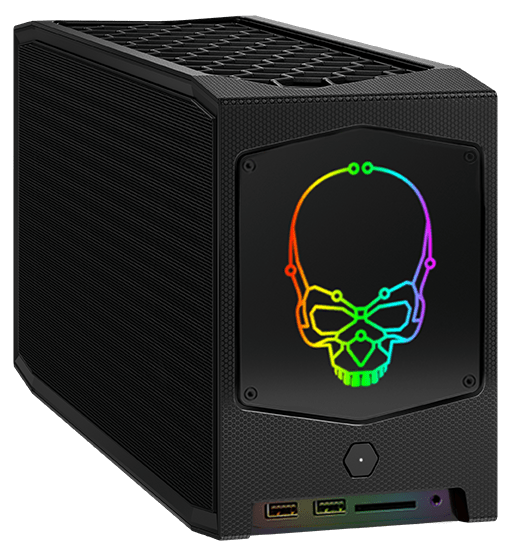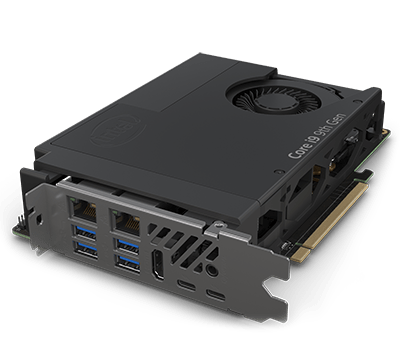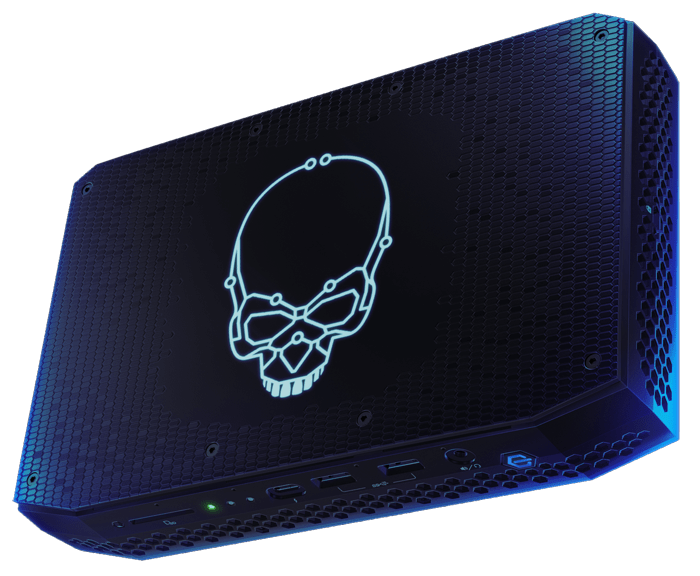Last Updated on

I love mini-PCs, the cute little machines that can quietly sit on your desk, doing the generic office work of the day or handling smaller, less intensive tasks. What more do you need than that? Well, apparently someone rattled the cages of the ‘gamers’ and now we’re seeing more and more powerful Intel NUCs, portable PCs, and more from manufacturers. Hence, the Beast Canyon is the logical conclusion of Intel’s quiet push into the gaming market via their ‘Skull Canyon’ line of PCs, which then manifested itself into the ‘Ghost Canyon’.
These small, powerful machines came either barebones or places like SimplyNUC would build them for you, but almost always came with mobile or a fork of the current full-fat Intel CPUs of the time (H, B or KB is often seen at the end of the CPUs). This made them great for light, esports games like Counter-Strike, League of Legends, or Hearthstone. Of course, with the inclusion of Thunderbolt 3 in the back of some of the models, you attach a full-size GPU via an external box, for a very convoluted method of playing anything more intensive.
Ghost Canyon improved on the basis but wound up enlarging the size of the device to that of a brick. Weirdly, people keep measuring these things in liters, which is hilarious.
With the introduction of a 500W power supply, the Ghost Canyon could support an NVIDIA RTX 2070, but it was a very tight squeeze and you’d have to buy specific models to get it lodged into the gap left for it.
The neat thing about Ghost Canyon was the introduction of the Compute Elements to these brands of mini-PCs, which are effectively PCIe cards with the CPU soldered in, M.2 drive slots, and all your inputs and outputs on the back. This meant upgrading the device to the next version should theoretically be a sinch, due to the fact you pop it out (albeit with a lot of hassle) and then replace it with your new card next upgrade cycle.
However, the Ghost Canyon unfortunately only supports PCIe 3.0 on its slots, meaning that Intel has had to put out a small asterisk with the announcement of the Beast Canyon that utilizing the new Element in the last chassis – as was intended for the upgrade cycle – will in fact cause the audio ports on the front to be unsupported and because the last chassis had PCIe 3.0 in it, no real support for 4.0 is expected.
The Mighty Beast

The Beast Canyon comes equipped with one of three setups, along with a 650W power supply. i9, i7, and i5 are your selections, with the i9-11900KB, i7-11700B, and i5-11400H embedded within the Element. This means that the i9 is the only one that can be overclocked, but the point of these devices is to have a ‘set it and forget it’ type machine. If you buy them barebones, you’ll have nothing inside, except some slots for DDR4 RAM, NVMe SSD slots, and your CPU’s included internal graphics card, which is currently able to output in 4K.
The device can hold up to 64GB of RAM, has three M.2 slots, with only one of them being Gen4, while the others sit at Gen3. An SDXC card slot with UHS-II capabilities is also on the machine.
Because of the Beast Canyon’s PCIe 4.0 capabilities, this should be the one to last a little longer than the ill-fated Ghost Canyon, which will become hotly out of date as PCIe 3.0 is phased out. This means that the next iteration should just be an Element swap away.
Speaking of the Element, the little device inside that is the brains of the NUC, it now supports Thunderbolt 4 and has 2.5Gb LAN connectivity, so the wired connection will be wicked fast, while the Wi-Fi is the newest 6 variant.
Of course, the coup de grace is the new inclusion of enough room (8 liters of space!) for a 12-inch graphics card and enough power from the 650W power supply for a maximum of 3080Ti, making it top out at supporting a 350W GPU.
Beast Canyon Specs
If you want to see more than the highlights, SimplyNUC currently has a fairly in-depth, if a little incorrect (says the i9-9980HK is in it, when it’s an 11th generation device) specs sheet for those interested.
Specifications:
For a quick look to see if the Beast Canyon specs meet your expectations, you can see them below:
• 11thGen Intel® Core™i9–11900KB
• Intel® UHD Graphics
• PCIe Gen4 x16 and x4 Gen4 slots
• Two DDR4–3200 SO–DIMM Sockets
• One M.2 socket for PCIe Gen4
• Two M.2 sockets for PCIe Gen3 or
SATA SSDs
• One CPU–attached M.2 slot 42/80/110
PCIe X4 Gen 4
• Intel® Optane™Memory ready
• HDMI 2.0b supporting 4K @ 60Hz
• Dual Thunderbolt 4 (supports Alt–DP)
• Intel® 2.5 Gb LAN
• Intel® Wi–Fi 6E
• Intel® Bluetooth 5.2
• Internal Dual–Band Antennas
• EIght USB 3.2 Gen 2 Ports (10Gb/s)
• SDXC card slot (UHS–II)
• Digital Audio 7.1 Surround Sound
• Front 3.5mm headset jack
• Kensington lock support
• 650W 80+ Goldinternal power supply
• Customizable RGB lighting
• User–replaceable RGB–backlit front logo
The Beast Canyon NUC is available on SimplyNUC, preconfigured without a GPU starting at £929/$1299 for the i5 model, £999/$1399 for the i7, and £1149/$1599 for the i9 model. It will ship from September.
I need something smaller?

Intel are still actually producing models more in line with the original Skull Canyon, flat-top model that comes with VESA mounting for getting it entirely out of the way. The current generation obviously has 11th Gen Intel CPUs inside, runs the new Xe integrated graphics, and has similar inputs, like Thunderbolt and USB-C, for bolting on external GPUs or PCIe cages for doing a little more with it. Inside this one though, is a custom RTX2060, which holds its own if you’re intending to game at 1080p or a max of 1440p.
These devices also make for great light productivity or creative machines, so if you’re in the business of streaming and want an external PC to offload some of the work onto, this might be a good shout when combined with a capture card.



